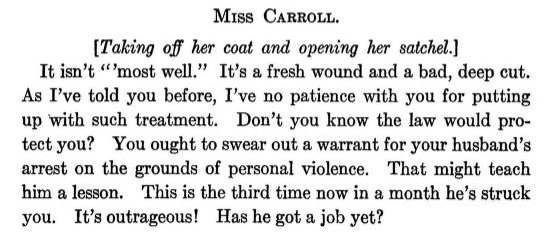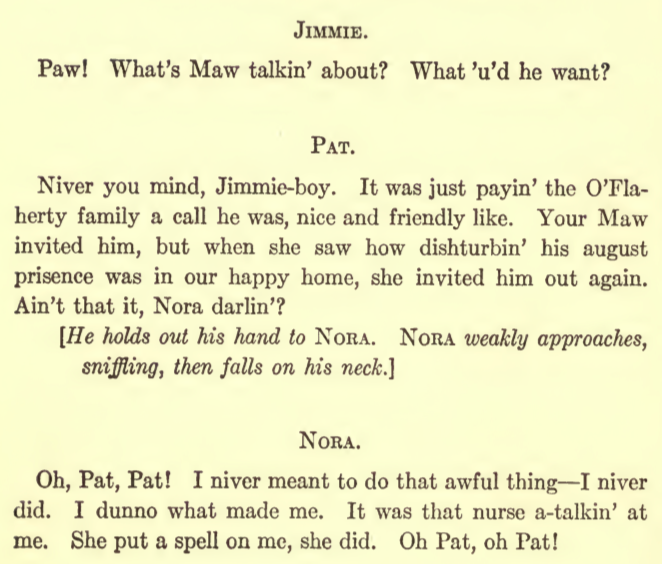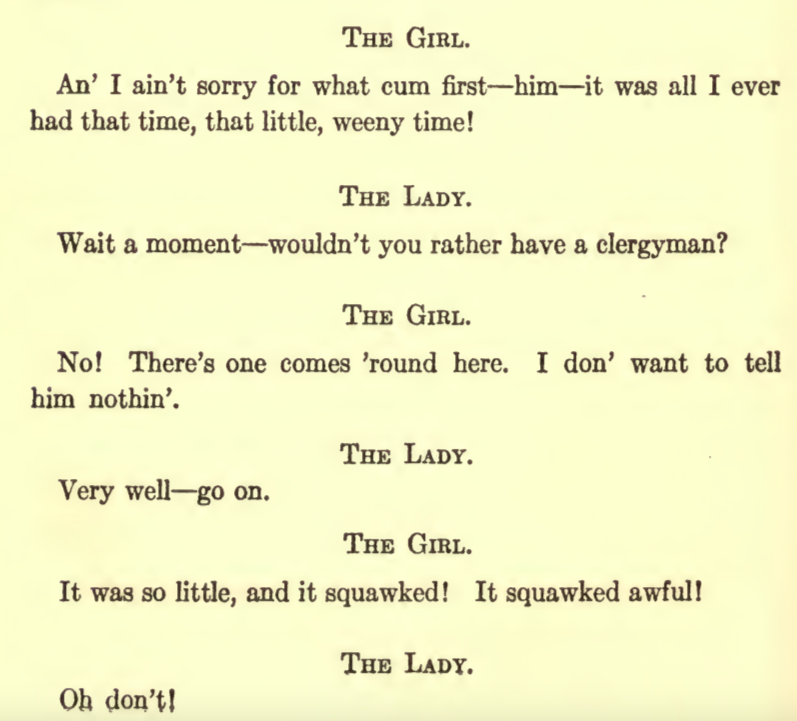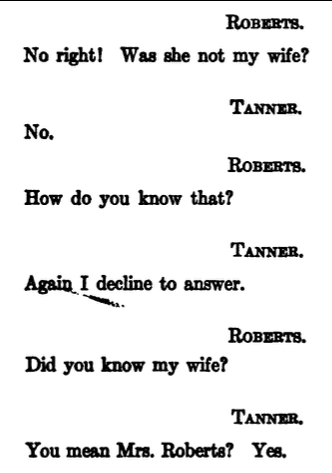In 1915 Mary Aldis published a volume of plays which may be considered a part of the Little Theatre movement then sweeping the American theatre world. We’ve covered the little theatre movement before, especially in the post about Alice Gerstenberg. Neith Boyce is another post from that movement.

In short, the Little Theatre movement was blowback against the near-monopoly big theatre companies had. One example would be that theatres in a town would be under contract to wait for a known troupe or company to come into town. This would discourage local theatre from growing. I believe it is time for a Little Theatre renaissance, but that’s for later.
“Big Theatre” I guess could be the Manila galleon of the theatre world, stopping by every so often to deliver theatre.
Chicago was a hub of the movement and that’s where Aldis worked her magic.

There were a few notes in her preface that stood out:

Make what you will of that, she remarks…

She also mentions the sorts of plays they put on:

She had this to say about theatre directing:


Hehe.
Mrs. Pat and the Law
The first play in the volume seems to be the most well-known and arguably the best-written. It concerns a visiting nurse and spousal abuse. The play is supposedly based on an actual case.
The family are Irish immigrants in Chicago. Nora Flaherty is the mother of Jimmie, a boy with a chronic leg condition. Unfortunately for Nora, she is also the wife of Pat, who has a chronic case of being an abusive man-child and a useless human being.
Kindly nurse Miss Carroll visits every now and again to check on Jimmie.
We meet Nora, who works hard as a laundress. She has a massive head wound.
Miss Carroll shows up.


Miss Carroll tries her best.


Miss Carroll leaves. Pat comes home. Acts like a sod.
Meanwhile, guess what Nora did while Pat was looking for a job getting wasted?

But Nora seems to have a touch of battered wife syndrome.


Miss Carroll returns, to inform Jimmie that she’ll get him a coat he was wanting.

Nora loses it.


So Carroll leaves and Pat promises to find work. But….he needs money.

20 cents in 1915 is sort of like five dollars in 2019. He goes drinking looking for work and Nora continues the wash.
The play ends as it does so often in real-life: the abuser goes unpunished and a child grows up in an abusive household.
That is the absolute power of the play. It doesn’t have a happy ending and it stays with you.
At the time, the portrayal of Irish in America was considered authentic by some. Pearl Vivian Willoughby even cites Aldis’ play in her 1923 doctoral thesis as an example of “local color”:

And then there’s this:

The Drama League Monthly, in its review from March 1918 seems to consider it a serious play:

I wonder how it was read. In finding memories of a college actor from the early 20s online, I found this quote: ‘he “often put the audience into convulsions of laughter” as Mr. Pat in the play “Mrs. Pat and the Law.“‘
Pat is an oaf and does some dumb stuff, but the fact he’s an abusive bastard outweighs any humor his character posseses.
Here’s a review from Alfred University’s student newspaper in 1921.

An Irish play written by a rich American.
It seems to have been a popular college theatre choice. Ithaca College performed “Mrs. Pat” in 1928 and the University of Utah performed it in 1929.
From an Austin student paper in 1934:

It was produced in a high school in Salem, Ohio in 1922. Glenville, West Virginia also produced it in 1925.
The following is from Mt. Vernon, New York in 1935.

Numerous other productions can be found, but they seem to have tapered off after the 1930s.

The Drama Class of Tankaha, Nevada
Fortunately there is no Tankaha, Nevada.


This is about one of those society ladies’ “culture clubs” whose idea of culture seems to be reading the King James version of the Old Testament.
Even Omar Khayyam drives them into a tizzy.

This reminds me of Eugene O’Neill’s Ah, Wilderness! (set in 1906). The main character’s possession of Khayyam’s The Rubiyat is cause for concern for his family. We can also blame the Little Theatre movement for O’Neill’s success. Sigh.
One member has been assigned an Italian writer, Giacosa, but comes up short.

She has a point.


The play-within-a-play is a real play...
The good ladies discuss several questions in connection to the play.




Whaaaaa????? Really not liking Mrs. Fessenden right now.


Oh no, Miss Fessenden is on the path of wayward youth.

The play has some fun dialogue. Again, the young Miss Fessenden knows more than the so-called grown-ups. And projects a bit.


WHOA!!!! Miss Fessenden dishes it out….

I really like what Mrs. Bennett does here, standing up for the younger person.

I think this play would definitely be worth producing again despite Mrs. Fessenden’s weirdness regarding “Latin” authors. She would be even more dimwitted and xenophobic in 2019, thus making her own daughter and Mrs. Bennett a bit more “aware.”
Here’s what our old friend The Drama League Monthly said in their review:

Extreme Unction
Here Aldis gets involved in the debate over whether an afterlife exists. And she seems to have a touch of social critique as well, given the stereotypes archetypes characters she employs:

The dying prostitute isn’t very old. Probably not even out of her teens. But she is tough – at least on the surface. There is a society lady who is slumming visiting the sick, poor and indigent. She offers to read The Girl a story.

“The one about the valley…” If you’re not familiar with said Psalm, it is right here.

So thus begins a religious debate and The Girl is straight to the point:

The Lady does admit she’s done bad stuff in her life….

I guess when you’re a dying prostitute in a play you really don’t care. Nice conflict.

Who says she needs to be sorry?

The Girl appears to be guilty of infanticide….
But it was all worth while because…

Well, first, I wonder if the double meaning and spelling of “come” is on purpose.
At least she enjoyed herself. For a short time.
Here Aldis’ dialogue comes on strong. Describing a baby as “squawking” is pretty harsh.
The tough façade fades away. She gets emotional.

So now The Lady notices a Salvation Army marching band.
Historical note: While we may know the Salvation Army mostly for its thrift stores…

Or though its Yuletide bellringers:
In the olden days, The Salvation Army had a marching band that would go through town because people really respond to evangelistic marching bands they were annoying.

Often, when a film is set in a town between around 1900 to World War I in America, there’s an obligatory Salvation Army band (or similar) scene, including The Wild Bunch.
This is the “South Texas Temperance Union” or something…
Our play’s marching band doesn’t end in a bloody shootout. Instead The Lady asks the band’s singer, The Lassie, to help cheer up The Girl. It goes as well as you’d expect.

If you’re not familiar with the song she’s trying to sing, it’s the same one from The Wild Bunch.
The Lassie leaves.

The Doctor seems to have the mosts sense, so far.

The Doctor tells her it will be around a couple months….

The Doctor reflects on The Girl’s situation.

The Doctor makes a proposal. He wants her to report back to him on the afterlife (if possible). He has loads of questions. She thinks he’s joking.

He’s basically encouraging her to go seek out the afterlife. This puts her at ease and she falls asleep at the end, though my feeling is she may have just died.
And a contemporary assessment:

The Letter
Basically in this volume, the quality of play shows diminishing returns as one moves forward. We can look briefly at the the remaining two plays.
The Letter concerns two men who discover they shared the same woman. And she is now dead. But she left a letter and they both want to read it for some reason.



“One does not steal letters” <<< best line in the show.

Roberts proves to be one of the more progressive husbands of 1915.



He wants the letter so he can use it in his novel, not because of his affection for the dead woman. Womp womp.

Pretty much.
Temperment
This play is kinda amusing. Hugh seems to be well off and lives with a doting wife, Annabelle. However, apparently, one can be TOO doting as it seems Hugh gets tired of goodly Annabelle’s virtues. She’s ruining his life as a pianist.



Annabelle doesn’t tolerate Hugh’s douchiness one bit. Hehe.

Ha ha Hugh. Life is gonna suck for you.
And like a proper Bohemian, he’s moved to Greenwich Village.

He lives with Gladys.


Hugh is tired and extremely hungry.

And Gladys is no Annabelle.
She insults his art.


Hugh has nothing in this life, not even food. But he does have Gladys.

I love that stage direction: “panther spring.”

And thus ends the fable of Hugh and Annabelle and Gladys.
Mary Reynolds Aldis was born in Chicago in 1872. She attended St. Mary’s School in Knoxville, Illinois.
She married Chicago developer Arthur T. Aldis in 1892. She founded the Lake Forest Players in 1910. Her family had a bit of a surprise.
“I never thought of publishing these plays until Margaret Anderson of Little Review fame wanted to print Extreme Unction. . . . My conservative family were startled by the picture of me on the cover.”
To found the company, Harriet Monroe remembered, Aldis “tore out partitions in an old frame cottage . . . and converted it into a practicable little playhouse. . . . This done, she proceeded to make actors out of some of her neighbors . . . holding them to a rigid schedule of rehearsals, and soothing agitated amateur nerves by posting a motto in the green room, ‘Remember, this is for fun.’
This theatre continued until 1915. After the First World War, she was president of the Visiting Nurse Association of Chicago. She was a friend of Mildred Barnes Bliss, with whom she corresponded since at least 1903.
Together with her husband, she provided financial support to numerous artistic ventures, including Poetry magazine and, in the summer of 1923, the Wharf Players in Provincetown, Massachusetts, a theater troupe that included Harry Kemp, Mary Heaton Vorse, Frank Shay, and others. According to Kemp’s biographer, William Brevda, Aldis rescinded her patronage of the group after they held a wild party next to her Provincetown lodging and failed to invite her or any of the Players’ other wealthy patrons.
Note to starving artists: When we have our wild parties, be sure to invite our wealthy patrons so we can still afford our wild parties…it’s not like we ever work or write or anything.

